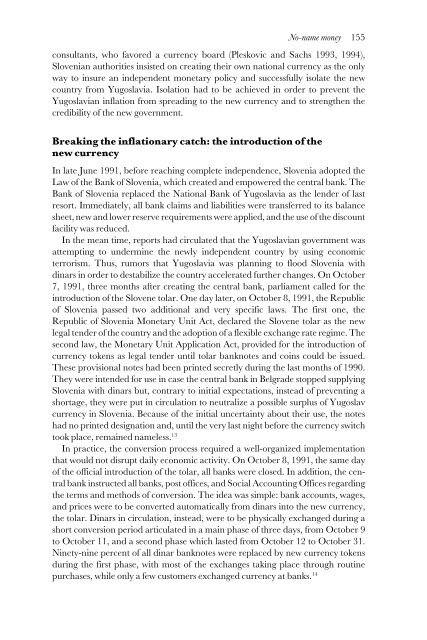Money and Markets: Essays in Honor of Leland B. Yeager
Money and Markets: Essays in Honor of Leland B. Yeager
Money and Markets: Essays in Honor of Leland B. Yeager
You also want an ePaper? Increase the reach of your titles
YUMPU automatically turns print PDFs into web optimized ePapers that Google loves.
No-name money 155consultants, who favored a currency board (Pleskovic <strong>and</strong> Sachs 1993, 1994),Slovenian authorities <strong>in</strong>sisted on creat<strong>in</strong>g their own national currency as the onlyway to <strong>in</strong>sure an <strong>in</strong>dependent monetary policy <strong>and</strong> successfully isolate the newcountry from Yugoslavia. Isolation had to be achieved <strong>in</strong> order to prevent theYugoslavian <strong>in</strong>flation from spread<strong>in</strong>g to the new currency <strong>and</strong> to strengthen thecredibility <strong>of</strong> the new government.Break<strong>in</strong>g the <strong>in</strong>flationary catch: the <strong>in</strong>troduction <strong>of</strong> thenew currencyIn late June 1991, before reach<strong>in</strong>g complete <strong>in</strong>dependence, Slovenia adopted theLaw <strong>of</strong> the Bank <strong>of</strong> Slovenia, which created <strong>and</strong> empowered the central bank. TheBank <strong>of</strong> Slovenia replaced the National Bank <strong>of</strong> Yugoslavia as the lender <strong>of</strong> lastresort. Immediately, all bank claims <strong>and</strong> liabilities were transferred to its balancesheet, new <strong>and</strong> lower reserve requirements were applied, <strong>and</strong> the use <strong>of</strong> the discountfacility was reduced.In the mean time, reports had circulated that the Yugoslavian government wasattempt<strong>in</strong>g to underm<strong>in</strong>e the newly <strong>in</strong>dependent country by us<strong>in</strong>g economicterrorism. Thus, rumors that Yugoslavia was plann<strong>in</strong>g to flood Slovenia withd<strong>in</strong>ars <strong>in</strong> order to destabilize the country accelerated further changes. On October7, 1991, three months after creat<strong>in</strong>g the central bank, parliament called for the<strong>in</strong>troduction <strong>of</strong> the Slovene tolar. One day later, on October 8, 1991, the Republic<strong>of</strong> Slovenia passed two additional <strong>and</strong> very specific laws. The first one, theRepublic <strong>of</strong> Slovenia Monetary Unit Act, declared the Slovene tolar as the newlegal tender <strong>of</strong> the country <strong>and</strong> the adoption <strong>of</strong> a flexible exchange rate regime. Thesecond law, the Monetary Unit Application Act, provided for the <strong>in</strong>troduction <strong>of</strong>currency tokens as legal tender until tolar banknotes <strong>and</strong> co<strong>in</strong>s could be issued.These provisional notes had been pr<strong>in</strong>ted secretly dur<strong>in</strong>g the last months <strong>of</strong> 1990.They were <strong>in</strong>tended for use <strong>in</strong> case the central bank <strong>in</strong> Belgrade stopped supply<strong>in</strong>gSlovenia with d<strong>in</strong>ars but, contrary to <strong>in</strong>itial expectations, <strong>in</strong>stead <strong>of</strong> prevent<strong>in</strong>g ashortage, they were put <strong>in</strong> circulation to neutralize a possible surplus <strong>of</strong> Yugoslavcurrency <strong>in</strong> Slovenia. Because <strong>of</strong> the <strong>in</strong>itial uncerta<strong>in</strong>ty about their use, the noteshad no pr<strong>in</strong>ted designation <strong>and</strong>, until the very last night before the currency switchtook place, rema<strong>in</strong>ed nameless. 13In practice, the conversion process required a well-organized implementationthat would not disrupt daily economic activity. On October 8, 1991, the same day<strong>of</strong> the <strong>of</strong>ficial <strong>in</strong>troduction <strong>of</strong> the tolar, all banks were closed. In addition, the centralbank <strong>in</strong>structed all banks, post <strong>of</strong>fices, <strong>and</strong> Social Account<strong>in</strong>g Offices regard<strong>in</strong>gthe terms <strong>and</strong> methods <strong>of</strong> conversion. The idea was simple: bank accounts, wages,<strong>and</strong> prices were to be converted automatically from d<strong>in</strong>ars <strong>in</strong>to the new currency,the tolar. D<strong>in</strong>ars <strong>in</strong> circulation, <strong>in</strong>stead, were to be physically exchanged dur<strong>in</strong>g ashort conversion period articulated <strong>in</strong> a ma<strong>in</strong> phase <strong>of</strong> three days, from October 9to October 11, <strong>and</strong> a second phase which lasted from October 12 to October 31.N<strong>in</strong>ety-n<strong>in</strong>e percent <strong>of</strong> all d<strong>in</strong>ar banknotes were replaced by new currency tokensdur<strong>in</strong>g the first phase, with most <strong>of</strong> the exchanges tak<strong>in</strong>g place through rout<strong>in</strong>epurchases, while only a few customers exchanged currency at banks. 14
















